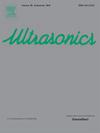在行波旋转超声电机中采用双模换能器,扩大了高效调速范围
IF 3.8
2区 物理与天体物理
Q1 ACOUSTICS
引用次数: 0
摘要
本研究提出了一种用于行波旋转超声电机(TRUM)的双模换能器设计,以解决传统单模换能器中狭窄的高效速度范围的固有限制,这严重阻碍了其在需要持续低速运行和瞬态高速调整的航空航天系统中的适用性。通过协同集成低阶(B03)和高阶(B09)振动模式,电机在扩展的运行速度范围内实现了更高的机电效率。基于Kirchhoff板的动态模型建立了模态特性和性能指标之间的定量关系,揭示了低阶模态通过更大的振幅放大扭矩容量,而高阶模态通过提高切向速度来优先考虑速度。微扰理论预测了不对称模态分裂磁化率,表明在等效制造缺陷下,低阶模态比高阶模态表现出更高的分裂倾向,并通过激光多普勒振动扫描实验验证了这一点。有限元驱动的结构优化使B03和B09模态振幅分别提高了78% (1400 ~ 2500 nm)和63% (800 ~ 1300 nm)。原型测试证实,双模TRUM的峰值效率分别为17.7% (B03模式)和16.5% (B09模式),与单模配置相比,其高效速度范围扩大了47%。微扰理论修正方法有效地减轻了B03模式分裂,在不破坏B09模态动力学的情况下,将失速扭矩提高了80%,效率提高了30.9%。该方法通过模式切换策略、模态分裂控制和多物理场优化来推进精密电机设计,为下一代高效超声致动器提供了范例。本文章由计算机程序翻译,如有差异,请以英文原文为准。
A dual-mode transducer in the traveling wave rotary ultrasonic motor to extend the high-efficiency speed range
This study proposes a dual-mode transducer design for the traveling wave rotary ultrasonic motor (TRUM) to address the inherent limitation of narrow high-efficiency speed ranges in conventional single-mode counterparts, which critically hinder their applicability in aerospace systems requiring sustained low-speed operation and transient high-speed adjustments. By synergistically integrating low-order (B03) and high-order (B09) vibration modes, the motor achieves enhanced electromechanical efficiency across an extended operational speed spectrum. A Kirchhoff plate-based dynamic model establishes the quantitative relationship between modal characteristics and performance metrics, revealing that low-order modes amplify torque capacity through larger amplitudes, while high-order modes prioritize speed via elevated tangential velocities. Perturbation theory predicts asymmetric modal splitting susceptibility, demonstrating that low-order modes exhibit higher splitting propensity than high-order modes under equivalent manufacturing imperfections—validated experimentally through laser Doppler vibration scanning. Finite element-driven structural optimization enhances B03 and B09 mode amplitudes by 78 % (1400–2500 nm) and 63 % (800–1300 nm), respectively. Prototype characterization confirms the dual-mode TRUM achieves peak efficiencies of 17.7 % (B03 mode) and 16.5 % (B09 mode), with a 47 % broader high-efficiency speed range compared to single-mode configurations. A perturbation-theoretic correction method effectively mitigates B03 mode splitting, improving stall torque by 80 % and efficiency by 30.9 % without destabilizing B09 modal dynamic. The proposed methodology advances precision motor design through mode-switching strategies, modal splitting control, and multi-physics optimization, offering a paradigm for next-generation high-efficiency ultrasonic actuators.
求助全文
通过发布文献求助,成功后即可免费获取论文全文。
去求助
来源期刊

Ultrasonics
医学-核医学
CiteScore
7.60
自引率
19.00%
发文量
186
审稿时长
3.9 months
期刊介绍:
Ultrasonics is the only internationally established journal which covers the entire field of ultrasound research and technology and all its many applications. Ultrasonics contains a variety of sections to keep readers fully informed and up-to-date on the whole spectrum of research and development throughout the world. Ultrasonics publishes papers of exceptional quality and of relevance to both academia and industry. Manuscripts in which ultrasonics is a central issue and not simply an incidental tool or minor issue, are welcomed.
As well as top quality original research papers and review articles by world renowned experts, Ultrasonics also regularly features short communications, a calendar of forthcoming events and special issues dedicated to topical subjects.
 求助内容:
求助内容: 应助结果提醒方式:
应助结果提醒方式:


